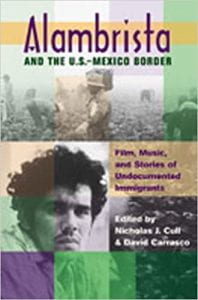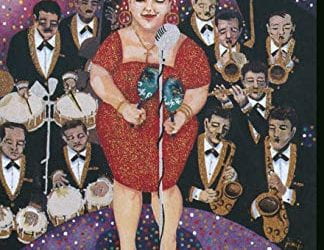A Review of Alambrista and the U.S.- Mexico Border: Film, Music, and Stories of Undocumented Immigrants
You Can Dance to this Book!

Alambrista and the U.S.- Mexico Border: Film, Music, and Stories of Undocumented Immigrants Edited by Nicholas J. Cull and David Carrasco University of New Mexico Press, Albuquerque, NM; 2004, 225 pp.
Whether it’s the traditional Mexican corrido that accompanies the birth of a baby girl in Michoacan, Mexico, or the “Okie-Dokie Shuffle” which underscores the diversity of cultures brought together within the migrant farmworker communities in California, the soundtrack that accompanies the recently released film Alambrista: The Director’s Cut will keep you moving. The multi-media production that is Alambrista and the US-Mexico Border; Film, Music and Stories of Undocumented Immigrants, co-edited by Nicholas Cull, American Studies professor at the University of Leicester, and David Carrasco, historian of religion and anthropology at Harvard University, demands the attention of students, scholars, and activists alike. Thirty years after Robert Young, AB ‘49 released the original version of the film Alambrista, this new combination of film, book and soundtrack invites us view the rerelease of Alambrista: The Director’s Cut, explore the themes that intersect immigrant lives through a superb collection of essays, and dance a little along the way to the soundtrack by Dr. Loco & Sus Tiburones Del Norte.
Carrasco comments, “A group of experienced scholars and activists, largely but not exclusively Chicanos from different universities came together to create a new educational resource that would allow people to read, see and hear the stories of the alambristas.” By bringing the original film back to life, these scholars intended “to heighten and stimulate dialogue in university classrooms and community centers alike, in order to enlarge the public discourse on undocumented workers in arenas such as public policy and the creative arts,” Carrasco adds. True to the collaborative spirit of this volume, the editors took the new version of the film Alambrista: The Director’s Cut to immigrant communities for their feedback. Cull remarks, “(Farmworkers’) overwhelming response to the film was to embrace it not as a window on the present situation but a piece of community history: a way of understanding their parents’ experience…For the children of the people who lived through such conditions, it fills a silence.”
Alambrista: The Director’s Cut portrays Roberto’s poignant journey of discovery and hardship in California in the 1970s. The viewer tastes both the sweetness of Roberto’s tender friendships, as well as the bitterness of his unjust exploitation as an undocumented immigrant worker. The spirit of generosity and clever humor that defines the relationship between Roberto and his comrade Joe stands in contrast to the inhumane treatment of the Colorado patron who just wants to recruit enough “bodies” to pick the melons in fields where farm workers are striking to protest unfair working conditions. Roberto experiences the wonder of sudden immersion within a new cultural setting: his wideeyed innocence prompts Joe to give him his first English lessons in ordering ham, eggs and coffee. Their risky adventures continue as they “cruise” in a Cadillac parked aboard a car carrier on a freight train bound for Stockton, California. Their jovial friendship ends in tragedy, leaving Roberto to wander alone into the next town, right into the arms of a budding romance with Sharon, an Anglo waitress in the diner where he orders his first meal. Roberto and Sharon’s intimacy and mutual dependence provide a temporary oasis of affection for them both. Roberto eventually crosses back over the border to Mexico, only to witness joy and sorrow simultaneously in seeing a Mexican woman giving birth to a future American citizen, an infant “with papers,” just yards over the national boundary line.
This collection of essays presents the “marriage between the academic perspective and the experience of culture,” according to Stanford University historian Albert Camarillo. Videotaped interviews follow the footage of Alambrista: The Director’s Cut, providing students with essential information about the contemporary realities of immigration in the new millennium. In one interview, for example, Latino Studies scholar Nancy Mirabal highlights the contemporary roles of increasing numbers of undocumented women who emigrate from Mexico to the U.S. As Theresa Carrillo emphasizes in her article entitled, “Watching Over Greater Mexico: Recent Mexican Initiatives on Migration and the Alambristas of the New Millennium,” the face of immigration thirty years after the making of the film Alambrista looks much different.
The book’s essays also illuminate various aspects of the production of the film and soundtrack. Jose Cuellar, professor of Raza Studies at San Francisco State University (aka Dr. Loco), provides us his “notes” on creating the original music for the film. Carrasco comments, “It’s really Dr. Loco’s music that makes a new version of the film. Dr. Loco’s music tells the Alambrista story in a new way with new nuances and new power.”
The complexities of Dr. Loco’s musical creations are expressed in his description of the “Okie Dokie Shuffle,” the “musical glue” overlaying the scenes where Joe and Roberto help a migrant “Okie” family get their broken-down station wagon moving again. Dr. Loco states, “This seemed to be the perfect film moment for a musical transculturation bringing together the mojados or ‘wetbacks’ and the gringos or ‘okies’…to instrumentally represent the musical merging of the Anglo and Mexican American traditions along the US-Mexican border.” When their car won’t start up at the gas station, the “Okie” father jumps out of the car and gives the driver’s side door a kick while Roberto turns the key in the ignition. As the car responds and they drive away, the song plays:
You shuffle to the left
You shuffle to the right
You shuffle around with all of your might
When nothing you do ever turns out right
That’s the Okie Dokie shuffle.
Alambrista and the US-Mexico Border; Film, Music and Stories of Undocumented Immigrants is already playing a major role in new collaborative efforts within the field of Latino Studies. For example, the newly formed Latino Studies Consortium, supported by DRCLAS and the Inter-Faculty Committee on Latino Studies at Harvard came together in response to the need for further collaboration in the area of Latino Studies. Tufts University anthropology professor Deborah Pacini Hernandez points out that faculty from both private and public institutions in the Boston area, met “to strengthen Latino scholarship within their institutions, get to know other Latino Studies faculty, and to create opportunities to connect in meaningful ways with the larger Latino community.”
Recognizing the Alambrista multimedia ensemble as a powerful tool to launch a new collaborative teaching initiative, the Consortium developed the project “A Book and a Film.” Over the course of the Fall 2004 semester, students from participating universities will screen Alambrista: The Director’s Cut, view the accompanying interviews prominent Latino Studies scholars, and read a selection of essays from Alambrista and the U.S.-Mexico Border. In response to the range of discussion questions posed at the beginning of the book, students will interact with one another through the use of a virtual discussion board. In their virtual classroom, students will have the opportunity “to dialogue and respond to their peers who are of different socio-economic backgrounds, who are engaged in the pursuit of various educational degrees, and who possess varying levels of expertise within the field of Latino Studies,” states Pacini. Students will also be able to gain feedback from participating faculty members across these institutions through these virtual discussions. For example, a Salem State masters degree candidate in education well-versed in Latino Studies with teaching experience, will have the chance to interact with Tufts undergraduate students entering their first Latino Studies course.
“In a political moment when Latin America is not part of the foreign policy debate and discussions of immigration issues have fallen by the wayside, this volume provides an opportunity for students to question this ‘silence’” remarks Neida Jimenez, DRCLAS Program Manager and coordinator of the Latino Studies Consortium. “Though a pilot project at the moment, the “Book and a Film Project” also helps faculty using these multi-media tools to engage in a pedagogical discussion about what it means to teach Latino Studies,” emphasizes Jimenez. “We know that music speaks to students; and stories move and stir the imagination: these too can be transformative tools.” Within this new collaborative teaching project, students will tackle the themes and questions raised by Alambrista and the U.S.-Mexico Border in virtual conversation with one another; university faculty will have the chance to dialogue about pedagogical aspects of teaching Latino Studies, all with an eye towards sharing this learning with K-12 educators.
The multi-media package thus becomes a point of departure for study in many different areas: the changing face of Mexican immigration to the US, the development of new pedagogies for Latino Studies, and the use of the creative arts, especially music and film, in the struggle to enact social change. All proceeds from the sale of this multi-media package benefit children of migrant farmworkers.
Fall 2004/Winter 2005, Volume III, Number 1
Cecilia Owen is an MDiv student at Harvard Divinity School studying art as ministry for social change. She is the coordinator of the “Book and a Film” project of the Latino Studies Consortium. A longer version of this article can be found on http://drclas.fas.harvardedu/publications
Related Articles
Editor’s Letter: Flora and Fauna
Ellen Schneider’s description of Sandinista leader Daniel Ortega in her provocative article on Nicaraguan democracy sent me scurrying to my oversized scrapbooks of newspaper articles. I wanted to show her that rather than being perceived as a caudillo
Bilingual Aesthetics: A New Sentimental Education
After an exhausting game of soccer with a crew of Mexico City street children, Vicente, a young teenager of 13 said, “Vamonos a la verga.” It was my third day with Casa Alianza, the international…
Nature and Citizenship
Two first-time visitors to the Galapagos archipelago begin their experience in exactly the same way. Two hours after departing mainland Ecuador, their plane descends towards the island of…




